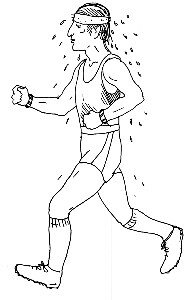STRANGE BUT TRUE- Bring it on! <i>Homo sapiens</i> can go the distance

Q. In the physical performance realm (biomechanics, etc), what do we humans do better than any other of the million+ known species?– F. Conte
A. In sheer aerobic endurance, a trained human is hard to beat, says Indiana University kinesiologist John S. Raglin. Animals may easily outpace us, but if the "race" is stretched out for hours or days, most researchers agree that humans would win the gold.
Upright humans are also extremely good at dissipating heat while other animals trap it with all their hair, explains biologist and anthropologist James Carrier, who says, "We're the best sweaters on the planet." Hence we become endurance walkers, bikers, marathoners.
Our easy bipedal locomotion serves another end, freeing our hands to do daily tasks even as we're on the go. Our fine motor control and coordination permit us to thread a needle and perform a whole array of extraordinary artistic and building tasks, adds Purdue kinesiologist Michael G. Flynn. We humans are without equals in tracking and catching objects, says Georgia State University sports scientist L. Jerome Brandon.
"How many animals could hit a baseball coming at 100 mph and send it 300 feet in the air? How many could strike a golf ball 270 yards down a fairway?" he asks. Behind this jack-of-all-tasks paramountcy sits our singular mind, driving us toward envisioned goals as we anticipate sweet success.
Q. What are the absolute best and absolute worst "buys" out there in the global marketplace these days? –W. Buffett
A. By far the best buys– in terms of bang per buck– are personal contributions to organizations that aid the poor in the poorest countries, such as Project Hope, Save the Children, CARE, etc, says Stanford University economist Roger Noll. These have been best buys for a long while because doing a great deal of good for the poorest of the poor is very, very inexpensive.
Sadly, the worst buys probably are in the area of cancer research; society spends so much on cancer research that diminishing returns have set in. Thirty-five years into the War on Cancer, the age-adjusted cancer death rate is down only slightly. Funding isn't the issue now; it's figuring out how to spend the money.
In the area of consumer goods, best is just about anything involving microprocessors and digital memory devices; prices are going down or staying stable as performance rises dramatically. As for investments, concludes Noll, whereas some opportunities will turn out a few years from now to rival an investment in IBM in 1950 or Xerox in 1970 or Microsoft in 1990, no one knows which these are. Bang per buck, yes, but only with a whole lot of luck.
Q. News is that scientists have learned how to switch earthquakes "off" and "on." So why not switch off the fault that might bring the Big One to San Francisco? –D. Gentry
A. The largest recorded quake was in Chile in 1960, where a slab of rock 800 x 200 kms slipped 21 meters past the adjacent rock, magnitude 9.5, says Nigel Calder in Magic Universe. Micro-earthquakes, with rock slippage or "creep" measured in mms, rank at magnitude 2– undetectable by people or distant seismometers.
But the little ones can grow into big ones, reasoned Hiroo Kanamori, at Tokyo University and Caltech. Since there are 100,000 times more quakes of magnitude 2 than 7, predicting the big ones is bound to be uncertain, as when forecasters failed to warn of the deadly Kobe earthquake in Japan in 1995.
Scientists can now switch earthquakes on by using water under pressure pumped in through boreholes close to fault lines, raising the possibility of "stage-managing" a lot of small quakes to relieve the San Andreas fault strain buildup, thus saving San Francisco. Some 500 boreholes 4000 meters deep might be needed to do this. An intriguing idea, yes, but politically explosive, says Calder. "Since every earthquake in California would be blamed on this, whether it was really responsible or not, litigation against the government would continue for centuries."
And who knows? The little ones just might backfire and trigger the dreaded Big One. Kanamori's caution: "Better not pull the tiger's tail."
Q. "People who need people are the luckiest people in the world," the old song says. Might your doctor agree? –T. DeMao
A. If she's up on the research, she would. While close relationships can be stressors in life, causing some of our greatest heartaches, more often they provide us with our greatest joys, contributing to our health and overall happiness, says David G. Myers in Social Psychology. People are good for us!
In 80+ studies, social support has been linked with healthier hearts and immune systems. People in close relationships eat better, exercise more, smoke and drink less. Moreover, in one five-year study of 423 elderly married couples, those who gave the most social support (running errands for friends, emotionally supporting their spouse, etc.) enjoyed the greatest longevity. On the other hand, lonely people have been shown to sleep less well, experience more stress, and fall into depressions.
"With few social ties with friends, kin or other members of close-knit religious or community groups, all of us," Myers writes, "are more likely to die prematurely."
Sorry, gotta go now. A friend's at the door...
Send Strange questions to brothers Bill and Rich at [email protected].
#